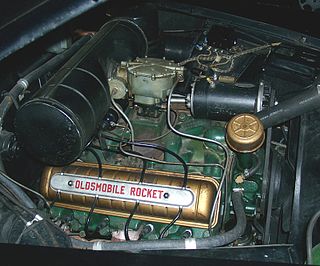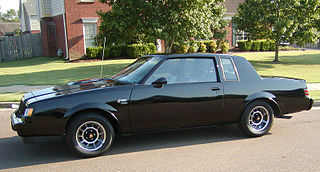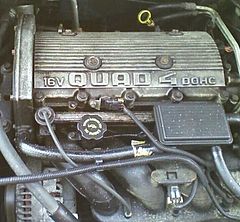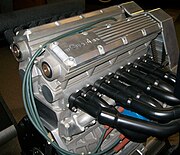
Oldsmobile was a brand of American automobiles, produced for most of its existence by General Motors. Originally established as "Olds Motor Vehicle Company" by Ransom E. Olds in 1897, it produced over 35 million vehicles, including at least 14 million built at its Lansing, Michigan factory alone.

The Oldsmobile Cutlass was a series of automobiles produced by General Motors' Oldsmobile division between 1961 and 1999. At its introduction, the Cutlass was Oldsmobile's entry-level model; it began as a unibody compact car, but saw its greatest success as a body-on-frame intermediate. The Cutlass was named after Vought F7U Cutlass, as well as the type of sword, which was common during the Age of Sail.

The Oldsmobile Cutlass Supreme is a mid-size car produced by Oldsmobile between 1966 and 1997. It was positioned as a premium offering at the top of the Cutlass range. It began as a trim package, developed its own roofline, and rose during the mid-1970s to become not only the most popular Oldsmobile but the highest selling model in its class.

The Iron Duke engine is a 151 cu in (2.5 L) straight-4 piston engine built by the Pontiac Motor Division of General Motors from 1977 until 1993. Originally developed as Pontiac's new economy car engine, it was used in a wide variety of vehicles across GM's lineup in the 1980s as well as supplied to American Motors Corporation (AMC). The engine was engineered for fuel efficiency, smooth operation, and long life, not for performance. Total Duke engine production is estimated to be between 3.8 and 4.2 million units.

The General Motors 60° V6 engine family is a series of 60° V6 engines produced for both longitudinal and transverse applications. All of these engines are 12-valve cam-in-block or overhead valve engines, except for the LQ1; which uses 24 valves driven by dual overhead cams. These engines vary in displacement between 2.5 and 3.4 litres and have a cast-iron block and either cast-iron or aluminum heads. Production of these engines began in 1980 and ended in 2005 in the U.S., with production continued in China until 2010. This engine family was the basis for the GM High Value engine family. These engines have also been referred to as the X engines due to their first usage in the X-body cars.

The Oldsmobile 4-4-2 is a muscle car produced by Oldsmobile between the 1964 and 1987 model years. Introduced as an option package for US-sold F-85 and Cutlass models, it became a model in its own right from 1968 to 1971, spawned the Hurst/Olds in 1968, then reverted to an option through the mid-1970s. The name was revived in the 1980s on the rear-wheel drive Cutlass Supreme and early 1990s as an option package for the new front-wheel drive Cutlass Calais.

The Buick V6 was an OHV V6 engine developed by the Buick division of General Motors and introduced in 1962. Originally 198 cu in (3.2 L) and initially marketed as Fireball, it later became popularly referred to as the 3800 for its various 3.8 L (230 cu in) incarnations.

The Oldsmobile V8, also referred to as the Rocket, is series of engines that was produced by Oldsmobile from 1949 until 1990. The Rocket, along with the 1949 Cadillac V8, were the first post-war OHV crossflow cylinder head V8 engines produced by General Motors. Like all other GM divisions, Olds continued building its own V8 engine family for decades, adopting the corporate Chevrolet 350 small-block and Cadillac Northstar engine only in the 1990s. All Oldsmobile V8s were manufactured at plants in Lansing, Michigan while the engine block and cylinder heads were cast at Saginaw Metal Casting Operations.

The Oldsmobile Diesel engine is a series of V6 and V8 diesel engines produced by General Motors from 1978 to 1985. The 350 cu in (5.7 L) V8 was introduced in 1978, followed by a 261 cu in (4.3 L) V8 only for the 1979 model year. In 1982, a 263 cu in (4.3 L) V6 became available for both front and rear-wheel drive vehicles. Sales peaked in 1981 at approximately 310,000 units, which represented 60% of the total U.S. passenger vehicle diesel market. However, this success was short-lived as the V8 diesel engine suffered severe reliability issues, and the engines were discontinued after the 1985 model year.

The General Motors N platform was a front-wheel drive compact automotive platform produced from 1984 to 2005. The GM N platform was based on the GM J-Body and replaced the GM X platform.

Atlas is a name for a family of modern inline piston engines for trucks from General Motors, used in the GMT355 and GMT360 platforms. The series debuted in 2002 with the Oldsmobile Bravada, and is also used in the Buick Rainier, the Chevrolet TrailBlazer and Colorado, the GMC Envoy and Canyon, the Hummer H3, Isuzu Ascender and i-370, and the Saab 9-7X. The engines use GM's Vortec name, and Straight-4, Straight-5, and Straight-6 engines are all part of the same family, sharing the same manufacturing equipment, rods, pistons, valves, and other parts. They feature coil-on-plug ignition systems, variable valve timing on the exhaust side, electronic throttle control, and a special oil pan with a pass-through for the half shafts in four-wheel drive vehicles. The inclusion of VVT on the exhaust camshaft side allows the Atlas series to meet emissions standards without the use of EGR, simplifying the engine design and increasing power for a broad power curve. The LL8 shares 75% of its components with the LK5 and L52; while the LK5 and L52 share 89% of their components.

The Oldsmobile Calais is a compact car that was manufactured and marketed by Oldsmobile from 1985 through 1991, superseding the Oldsmobile Omega and named after the city of Calais, France. Renamed the Cutlass Calais for 1988, and briefly available in 1987 as the limited edition GMO Quad 4, the Calais shared the GM N platform with the Pontiac Grand Am and the Buick Skylark/Buick Somerset — and was superseded by the Oldsmobile Achieva in 1992.

The 122 engine was designed by Chevrolet and was used in a wide array of General Motors vehicles. The 122 was similar to the first two generations of the General Motors 60° V6 engine; sharing cylinder bore diameters and some parts. The 122 was available in the US beginning in 1982 for the GM J platform compact cars and S-series trucks.

The Oldsmobile Achieva is a front-wheel drive compact sedan and coupe that was introduced by Oldsmobile for the 1992 model year. The Achieva was based on the GM N-body platform, which it also shared with its siblings the Pontiac Grand Am and Buick Skylark. The Achieva replaced the GM N-body Cutlass Calais after its final 1991 model year, and ended production after the 1998 model year.

The Pontiac Grand Am is a mid-size car and later a compact car that was produced by Pontiac. The Grand Am had two separate three-year runs in the 1970s: from 1973 to 1975, and again from 1978 to 1980. It was based on the GM A platform. Production of the intermediate sized Grand Am was canceled in 1980 when it was replaced by the Pontiac 6000. The compact-sized Grand Am was reintroduced in 1985 when it replaced the Pontiac Phoenix. It became Pontiac's best selling car and was later replaced by the Pontiac G6, so named as it was intended to be the 6th generation of the Grand Am.
The 4T60-E is a series of automatic transmissions from General Motors. Designed for transverse engine configurations, the series includes 4 forward gears. The 4Txx family is an evolution of the original Turbo-Hydramatic 125 transverse automatic introduced in the late 1970s.

The General Motors G platform was an automobile platform designation used for mid-sized rear-wheel drive cars. It made its first appearance from the 1969 to 1972 model years, adapted from GM's A-body, and reappeared from 1982 to 1988. The second series of G-bodies began production designated as A-body cars in 1978, but were redesignated as G-body when the new front-wheel drive A-body platform was introduced in 1982.
The GM A platform was a rear wheel drive automobile platform designation used by General Motors from 1925 until 1959, and again from 1964 to 1981. In 1982, GM introduced a new front wheel drive A platform, and existing intermediate rear wheel drive products were redesignated as G-bodies.

The Getrag 282 transmission was a 5-speed manual transaxle designed by Getrag for Chevrolet. It is sometimes referred to as the Muncie 282 or the Muncie Getrag 282, as the transmission was manufactured by the Muncie, Indiana manual transmission plant. It has been used in various front-wheel drive transverse engine applications including the Chevrolet Cavalier, Pontiac Sunbird, Pontiac Grand Am, Chevrolet Beretta and the Oldsmobile Achieva. It was also used in the mid-engined rear-wheel drive Pontiac Fiero. In its later years, the Getrag 282 was manufactured by New Venture Gear and renamed the NVG T550.



























